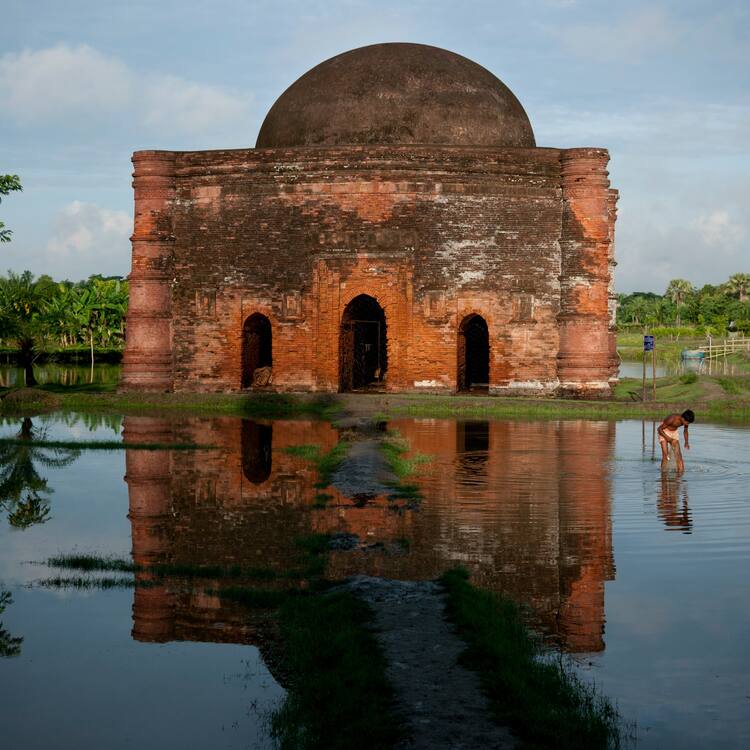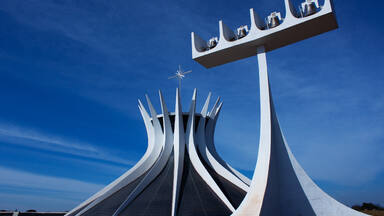Historic Mosque City of Bagerhat
Historic Mosque City of Bagerhat
Situated in the suburbs of Bagerhat, at the meeting-point of the Ganges and Brahmaputra rivers, this ancient city, formerly known as Khalifatabad, was founded by the Turkish general Ulugh Khan Jahan in the 15th century. The city’s infrastructure reveals considerable technical skill and an exceptional number of mosques and early Islamic monuments, many built of brick, can be seen there.
Description is available under license CC-BY-SA IGO 3.0
Ville-mosquée historique de Bagerhat
Au cœur des faubourgs de Bagerhat, au confluent du Gange et du Brahmapoutre, la ville ancienne, autrefois appelée Khalifatabad, fut fondée au XVe siècle par le général turc Ulugh Khan Jahan. Cette cité, dont les infrastructures attestent d’une grande maîtrise technique, regroupe un nombre exceptionnel de mosquées et de monuments anciens islamiques, dont beaucoup sont construits en brique.
Description is available under license CC-BY-SA IGO 3.0
المدينة التاريخية - المسجد في باغرهات
وسط الأحياء المجاورة لباغرهات، عند ملتقى الغانج والبراهمابوتر، تمّ تأسيس المدينة القديمة التي كانت في السابق تدعى خليفة آباد في القرن الخامس عشر على يد الجنرال التركي أولغ خان جاهان. وتجمع هذه المدينة التي تشهد بنيتها التحتية على تمرّس فني كبير عدداً استثنائياً من المساجد والنصب القديمة الإسلامية التي بُني الكثير منها بالقرميد.
source: UNESCO/CPE
Description is available under license CC-BY-SA IGO 3.0
巴凯尔哈特清真寺历史名城
这座古城位于巴凯尔哈特(Bagerht)城外的恒河(Ganges)和布拉马普特拉河(Brahmaputra)的交汇处。古城原名卡理法塔巴德(Khalifatabad),是由一位名叫乌鲁格哈贾汗(Ulugh Khan Jahan)的土耳其将军于公元15世纪建立的。城市的基础设施建设令人叹为观止,体现出很高的建筑技术和工艺。城中还有大量砖结构的清真寺和早期伊斯兰古迹。
source: UNESCO/CPE
Description is available under license CC-BY-SA IGO 3.0
Исторический город мечетей Багерхат
Старинный город, ранее известный как Халифатабад и расположенный в пригороде Багерхата у слияния Ганга и Брахмапутры, был основан тюркским полководцем Улуг Хан Джаханом в XV в. Структура города свидетельствует о значительном техническом мастерстве. Здесь и сегодня можно увидеть множество мечетей и древних исламских монументов, многие из которых построены из кирпича.
source: UNESCO/CPE
Description is available under license CC-BY-SA IGO 3.0
Ciudad-mezquita histórica de Bagerhat
Esta antigua ciudad, antaño llamada Khalifatabad, fue fundada en el siglo XV por el general turco Ulugh Khan Jahan y está ubicada en los arrabales de Bagerhat, en la confluencia de los ríos Ganges y Brahmaputra. Dotada de infraestructuras que atestiguan la pericia técnica de sus constructores, esta ciudad histórica posee gran número de mezquitas y monumentos islámicos antiguos, construidos principalmente con ladrillo.
source: UNESCO/CPE
Description is available under license CC-BY-SA IGO 3.0
バゲルハットのモスク都市
source: NFUAJ
Historische moskee-stad van Bagerhat
Source: unesco.nl
Outstanding Universal Value
Brief synthesis
The Historic Mosque City of Bagerhat is an important evidence of medieval city in the south-west part of present Bagerhat district which is located in the south-west part of Bangladesh, at the meeting-point of the Ganges and Brahmaputra rivers. The ancient city, formerly known as Khalifatabad, sprawls over on the southern bank of the old river Bhairab and flourished in the 15th century BC.
The magnificent city, which extended for 50 km2, contains some of the most significant buildings of the initial period of the development of Muslim architecture of Bengal. They include 360 mosques, public buildings, mausoleums, bridges, roads, water tanks and other public buildings constructed from baked brick.
This old city, created within a few years and covered up by the jungle after the death of its founder in 1459, is striking because of certain uncommon features. The density of Islamic religious monuments is explained by the piety of Khan Jahan, which is evidenced by the engraved inscription on his tomb. The lack of fortifications is attributable to the possibilities of retreat into the impenetrable mangrove swamps of the Sunderbans. The quality of the infrastructures - the supply and evacuation of water, the cisterns and reservoirs, the roads and bridges - all reveal a perfect mastery of the techniques of planning and a will towards spatial organization.
The monuments, which have been partially disengaged from the vegetation, may be divided into two principal zones 6.5 km apart: to the West, around the mosque of Shait-Gumbad and to the East, around the mausoleum of Khan Jahan. More than 50 monuments have been catalogued: in the first group, the mosques of Singar, Bibi Begni and Clumakkola; and in the second, the mosques of Reza Khoda, Zindavir and Ranvijoypur.
Criterion (iv): The Historic Mosque City of Bagerhatrepresents the vestiges of a medieval Muslim town in the northern peripheral land of the Sundarbans. It contains some of the most significant buildings of the initial period of the development of Muslim architecture in Bengal. Shait-Gumbad is one of the largest mosques and represents the flavour of the traditional orthodox mosque plan and it is the only example of its kind in the whole of Bengal. The second important monument, Khan Jahan's tomb, is an extraordinary representation of this type of architecture as well as calligraphic parlance.
The site exhibits a unique architectural style, known as Khan-e-Jahan (15th Century A.D.), which is the only known example in the history of architecture.
Integrity
The original picturesque location and the natural setting of these densely located religious and secular monuments along with the medieval form and design are intact. The property of the Historic Mosque City of Bagerhat contains and preserves all the necessary elements which include not only mosques but also residences, roads, ancient ponds, tombs, chillakhana (ancient graveyard). Therefore, the attributes of the city are still preserved.
The threat of the unauthorized activities by the community and the extreme salinity of the soil and atmosphere, which can potentially threaten the physical integrity of the attributes, are being closely monitored by the site managers. In particular, interventions are needed to preserve the Shaitgumbad Mosque.
Authenticity
In order to preserve the authenticity of the monuments, conservation and restoration actions have respected the use of original materials (lime and mortar). Notwithstanding, some of the original features, such as stone pillars inside the mosques, reticulated windows, pediment, upper band of cornice, were lost in earlier interventions.
Many of the structures continue to be in religious and secular use contributing to the social and communal harmony by the way of retaining the original features of traditional practices.
Protection and management requirements
The property is managed under the Antiquities Act, 1968 (Amendment 1976). In addition the Department of Archaeology protects the property under the Antiquities Export Control Act (1947), the Immovable Antiquities Preservation Rules (1976), the Conservation Manual (1923) and the Archaeological Works Code (1938).
The Department of Archaeology ensures that inappropriate activities which may affect the Outstanding Universal Value of property such as buildings or infrastructure cannot be constructed within or close to the property, and no one can alter or deface monuments within the property.
The Government of Bangladesh has worked on the implementation of recommendations set out in the Master plan prepared by UNESCO 1973/74-1977/78 for the conservation and presentation of the Historic Mosque City of Bagerhat. Though the financial efforts have been made to address the conservation problem derived from salinity, this has not been comprehensively solved and deterioration has continued. The implementation of the management plan, including conservation provisions, will need to be monitored so as to evaluate achieved results and provide new action plans in response to emerging conditions.
Conservation of the historic landscape, buffer zone and the property has yet to be addressed. A number of issues have recently been identified and will constitute the basis for a new project named “South Asia Tourism Infrastructure Development Project” (Bangladesh Portion), which is going to be shortly implemented. Challenges to sustainably manage these concerns, along with the conservation of the property, will need to be taken up to ensure the long term preservation and protection of its Outstanding Universal Value.

 View photos from OUR PLACE the World Heritage collection
View photos from OUR PLACE the World Heritage collection
